Grace Mappes
Ukrainian forces conducted counteroffensive operations on at least two sectors of the front and advanced near Robotyne. Geolocated footage published on August 19 and 20 shows that Ukrainian forces recently advanced east of Robotyne.[1] The Ukrainian General Staff reported that Ukrainian forces conducted counteroffensive operations in the Melitopol (western Zaporizhia Oblast) and Berdyansk directions (western Donetsk-eastern Zaporizhia Oblast area).[2] A Russian milblogger claimed that Russian forces continue to face issues with counterbattery capabilities on all sectors of the front, but particularly in the Zaporizhia direction.[3] The milblogger also claimed that Russian units are facing officer shortages due to manpower losses and that privates command some Russian companies, which should have a junior officer in command.[4]
Ukrainian strikes against Russian deep rear areas are generating discontent in the Russian information space and sparking criticism of the Russian military command, as Ukraine likely intends. Some Russian milbloggers expressed anger at recent Ukrainian strikes on the Kerch Strait Bridge and called for Russian forces to target the families, homes, and other properties of Ukrainian decisionmakers to deter further Ukrainian strikes against Russian deep rear areas.[5] The milbloggers referenced prior Soviet and Russian retaliatory strategies in Lebanon and in the northern Caucasus, and one milblogger claimed that it is easy for Russian officials to disregard the need for retaliation because Ukrainian strikes do not directly impact their livelihoods. Former Luhansk People’s Republic (LNR) Ambassador to Russia Rodion Miroshnik claimed on August 20 that strikes against Moscow are becoming normalized following three consecutive days of alleged Ukrainian strikes against the city and called on Russian forces to make retaliatory strikes “personally painful” for decisionmakers who ordered the Moscow strikes.[6] A Russian insider source claimed that Russian air defenses did not activate to defend against an overnight strike against a Kursk City rail station on August 19 to 20, highlighting a frequent milblogger complaint that Russian forces fail to defend against strikes on Russian territory.[7] The UK Ministry of Defense (MoD) assessed that the Russian leadership has likely been pressuring the Russian Aerospace Forces (VKS) command to improve Russian air defense coverage in western Russia, suggesting that both the higher Russian leadership and the ultranationalist information space are placing pressure on the Russian military command in response to the strikes.[8]
Ukrainian strikes on Russian rear areas are demonstrably degrading the morale of Russian forces in Ukraine, which could threaten the stability of Russian defenses on multiple critical areas of the front. Russian frontline units, particularly in southern Ukraine, have frequently struggled with degraded morale following Ukrainian strikes on rear areas.[9] Morale issues can quickly intensify and spread among Russian frontline units if one unit under pressure breaks, which could spread panic and significantly reduce the combat effectiveness of other Russian forces. A broken Russian frontline unit would threaten the integrity of other frontline defenses, and such a break in the Russian frontline would provide a vulnerability that Ukrainian forces could exploit. Russian forces also likely lack the necessary reserves to rotate out or quickly replace a broken unit, as ISW has previously assessed, making the preservation of morale in frontline units imperative.[10] Morale issues pertaining to the Russian defense against Ukrainian counteroffensive operations are only relevant if Ukrainian forces can degrade Russian morale to the breaking point and take advantage of it; these morale issues will not matter if Russian forces do not break under this pressure. There is no way to predict if, when, or where a Russian unit might break under sustained pressure, but Ukrainian forces are setting conditions to increase the likelihood of such a development.
Russian milbloggers criticized the Russian Ministry of Defense (MoD) for not preventing an alleged Ukrainian drone attack on Soltsy airbase in Novgorod Oblast on August 19 and for downplaying the severity of the damage to aircraft based there. The Russian MoD claimed on August 19 that Russian forces shot down a Ukrainian drone using small arms and that a fire damaged one aircraft but that firefighters promptly put out the fire.[11] Images published on August 20 reportedly show a Tu-22M3 (NATO reporting name Backfire-C) long-range supersonic bomber on fire at the Soltsy airbase.[12] A Russian insider source claimed that witnesses said that fire damaged or completely destroyed two aircraft.[13] Several Russian milbloggers claimed that Ukrainian forces used a small and relatively inexpensive quadcopter drone to conduct the attack and criticized the Russian MoD for not storing the aircraft in hangars, noting that even elementary protective structures and nets are reliable against quadcopters.[14] The damage or even destruction of two Tu-22M3 aircraft will not generate militarily significant effects in itself, but Russian milbloggers’ responses to the attack show the way in which such deep attacks support larger Ukrainian efforts to degrade Russian morale.
The Netherlands and Denmark confirmed that they will transfer F-16 fighter jets to Ukraine but did not specify when. Ukrainian President Volodymyr Zelensky traveled to the Netherlands on August 20 and met with Dutch Prime Minister Mark Rutte to discuss the transfer of the aircraft.[15] Zelensky stated that the Netherlands and Denmark will transfer 42 F-16 fighter jets to Ukraine, of which the Danish Ministry of Defense (MoD) specified that Denmark will provide 19.[16] Rutte stated that the transfers will occur when Ukraine meets certain conditions, which the Danish MoD announced includes US legal permission, the training of Ukrainian pilots, and the creation of support infrastructure in Ukraine.[17] US National Security Advisor Jake Sullivan stated on August 18 that the US will grant the legal permission after Ukrainian pilots complete their training on the aircraft.[18] Ukrainian Air Force Spokesperson Colonel Yuriy Ihnat stated on August 17 that Ukraine will not receive the fighter jets by the winter of 2023-2024.[19]
Ukrainian Air Force Commander Lieutenant General Mykola Oleshchuk nevertheless stated on August 20 that the provision of Western aircraft, such as the F-16, will allow Ukrainian forces to combat the main Russian aviation threat— the Su-35 fighter jet.[20] Oleshchuk assessed that if Russian forces lost between two and five percent of their current aircraft then Russian forces would temporarily stop flying combat missions to develop a response.[21] Oleshchuk argued that this temporary pause would give Ukraine temporary air superiority and therefore allow Ukrainian forces to significantly accelerate counteroffensive operations.[22] The impact of F-16 fighter jets on Ukrainian counteroffensive operations depends on numerous factors, and ISW offers no assessment of Oleshchuk’s argument at this time.
Russian officials have reportedly drafted a plan to conduct a decade-long ethnic cleansing campaign in occupied Mariupol, Donetsk Oblast. The Ukrainian Resistance Center reported on August 20 that Ukrainian partisans gained access to a Russian occupation development document that stipulates a 300,000 increase in Mariupol’s overall population by 2035 through migration from Russia.[23] The Resistance Center reported that an existing preferential mortgage program for Russians who move to occupied Mariupol is a part of this resettlement effort.[24] Russian occupation officials have engaged in a series of efforts to attract Russian citizens to the occupied territories in Ukraine, although this alleged document is the most detailed account of the extent of the Kremlin’s long-term repopulation goals.[25] Mariupol had a pre-invasion population of over 400,000 people and roughly 120,000 residents remained in the occupied city as of May 2023.[26] The Russian siege of Mariupol during the first phases of the Russian full-scale invasion killed up to 25,000 Ukrainian civilians and displaced hundreds of thousands from the city.[27] Russian officials reportedly deported an additional 50,000 residents from the city to Russia and other occupied territories in the months following its capture.[28] The development document’s repopulation goals indicate that the Kremlin intends to remake Mariupol as a predominantly ethnic Russian city after engaging in a systematic and likely intentional effort to depopulate the city of ethnic Ukrainians. ISW continues to assess that the ongoing Russian efforts to deport Ukrainians and repopulate Ukrainian cities with imported Russian citizens likely amount to a deliberate ethnic cleansing campaign in addition to being apparent violations of the Convention on the Prevention and Punishment of the Crime of Genocide.[29]
Wagner Group commanders accused two high-ranking Wagner representatives of betraying Wagner for the Russian Ministry of Defense (MoD)-affiliated Redut private military company (PMC).[30] Wagner commander Anton Yelizarov (known under the callsign “Lotos”) claimed that Andrey Troshev (known as “Sedoy”) left Wagner with another Wagner commander, who was later identified as Vadim V. (nicknamed “Khrustal”).[31] Yelizarov claimed that Troshev had never commanded Wagner units and was not a member of Wagner’s Council of Commanders. Wagner financier Yevgeny Prigozhin had repeatedly introduced Troshev as his personal representative prior to Wagner’s rebellion on June 24 and as the director of Wagner-affiliated “League for the Protection of the Interests of Veterans of Local Wars and Military Conflicts.”[32] Troshev appeared to be Prigozhin’s close confidant and had reportedly established connections with Putin and the Russian MoD through his work with Wagner.[33] Troshev has previously appealed to Russian President Vladimir Putin on behalf of Wagner, and Putin identified him as a Kremlin-affiliated Wagner commander on June 29.[34] The Wagner commander nicknamed Koldun claimed that “Khrustal,” who led Wagner’s personnel department, is now calling Wagner fighters to recruit them into a new PMC for operations in Africa.[35] A Wagner-affiliated milblogger and Wagner commanders criticized Troshev and “Khrustal” for cowardice and numerous personal and professional failures, and claimed that Wagner military commanders have not left Wagner.[36] Wagner sources also tried to downplay Troshev’s and Khrustal’s authority within Wagner.
Troshev’s and Khrustal’s betrayal of Wagner may represent a growing fracture within the Wagner leadership, indicating that the Kremlin’s and Russian MoD’s efforts to disband Wagner are partially succeeding. A Russian milblogger claimed that the Russian MoD continues to form new PMCs to immediately replace Wagner in Africa, despite the fact that such units reportedly need at least 12 to 18 months to train and to establish new relations with African countries.[37] The Kremlin and the Russian MoD are apparently using Troshev and “Khrustal” to recruit Wagner fighters and commanders under the promise of new missions in Africa while setting conditions to restrict Prigozhin’s contingent from continuing operations in Africa and the Middle East.[38] Wagner sources’ public denouncement of Troshev and “Khrustal” as cowards may indicate that Wagner commanders are attempting to deter other commanders and Wagner representatives from leaving Wagner.
Key Takeaways:
- Ukrainian forces conducted counteroffensive operations on at least two sectors of the front and advanced near Robotyne.
- Ukrainian strikes against Russian deep rear areas are generating discontent in the Russian information space and sparking criticism of the Russian military command, as Ukraine likely intends.
- Ukrainian strikes on Russian rear areas are demonstrably degrading the morale of Russian forces in Ukraine, which could threaten the stability of Russian defenses.
- The Netherlands and Denmark confirmed that they will transfer F-16 fighter jets to Ukraine but did not specify when.
- Russian officials have reportedly drafted a plan to conduct a decade-long ethnic cleansing campaign in occupied Mariupol, Donetsk Oblast.
- Wagner Group commanders accused two high-ranking Wagner representatives of betraying Wagner, possibly representing a growing fracture within the Wagner leadership and suggesting that the Kremlin’s and Russian MoD’s efforts to disband Wagner are partially succeeding.
- Russian forces conducted offensive operations near Kupyansk, Kreminna, Bakhmut, along the Avdiivka-Donetsk City line, and in western Donetsk-eastern Zaporizhia Oblast on August 20 and marginally advanced near Bakhmut.
- Wagner Group fighters continue to commit violent crimes after returning to Russia.
- Russian officials continue to forcibly transport mothers and children from occupied Ukrainian territories to Russia under the guise of medical retreats.
We do not report in detail on Russian war crimes because these activities are well-covered in Western media and do not directly affect the military operations we are assessing and forecasting. We will continue to evaluate and report on the effects of these criminal activities on the Ukrainian military and the Ukrainian population and specifically on combat in Ukrainian urban areas. We utterly condemn these Russian violations of the laws of armed conflict, Geneva Conventions, and humanity even though we do not describe them in these reports.
- Russian Main Effort – Eastern Ukraine (comprised of two subordinate main efforts)
- Russian Subordinate Main Effort #1 – Capture the remainder of Luhansk Oblast and push western into eastern Kharkiv Oblast and encircle northern Donetsk Oblast
- Russian Subordinate Main effort #2 – Capture the entirety of Donetsk Oblast
- Russian Supporting Effort – Southern Axis
- Russian Mobilization and Force Generation Efforts
- Activities in Russian-occupied areas
Russian Main Effort—Eastern Ukraine
Russian Subordinate Main Effort #1 – Luhansk Oblast (Russian objective: Capture the remainder of Luhansk Oblast and push westward into eastern Kharkiv Oblast and northern Donetsk Oblast)
Russian forces continued offensive operations northeast of Kupyansk on August 20 but made no confirmed gains. The Ukrainian General Staff reported that Russian forces conducted unsuccessful offensive operations near Synkivka (9km northeast of Kupyansk).[39] Russian Western Grouping of Forces Spokesperson Yaroslav Yakimkin claimed that Russian forces continued offensive operations in the direction of Vilshana (14km northeast of Kupyansk) and captured unspecified Ukrainian positions.[40] Russian milbloggers claimed that elements of the Russian 1st Guards Tank Army (Western Military District) continued to advance near Synkivka but noted that claims about the Russian encirclement or capture of the settlement are premature.[41] Kharkiv Oblast occupation administration head Vitaly Ganchev claimed on August 19 that Russian forces captured five unspecified settlements in Kharkiv Oblast in the past week, although ISW has not observed visual confirmation of this claim.[42] Russian sources have claimed that Russian forces have been steadily advancing northeast of Kupyansk for the past several weeks, although corresponding visual confirmation corroborating these claims has yet to emerge.[43] Russian sources previously claimed extensive Russian advances southwest of Svatove that visual evidence has still yet to confirm, suggesting that Russian sources may be engaging in a wider pattern of exaggerating Russian advances along the Kupyansk-Svatove line.[44] Russian sources may be exaggerating Russian advances to portray localized Russian offensive operations as more threatening in order to support the Russian effort to draw Ukrainian forces away from more operationally significant sectors of the front.[45] A Russian milblogger did acknowledge that Russian forces are struggling to advance near Synkivka and Petropavlivka (6km east of Kupyansk) due to Ukrainian minefields.[46]
The Russian Ministry of Defense (MoD) claimed that Russian forces repelled six Ukrainian assaults near Vilshana, Synkivka, and Ivanivka (km east of Kupyansk) in Kharkiv Oblast and Novoselivske, Luhansk Oblast (15km northwest of Svatove).[47]
Russian forces continued limited offensive operations in the Kreminna area on August 20 and made marginal gains. Geolocated footage published on August 20 indicates that Russian forces advanced northwest of Kreminna.[48] A Russian milblogger claimed that Russian forces advanced near Bilohorivka (12km south of Kreminna).[49]
The Russian MoD claimed that Russian forces repelled Ukrainian assaults near Torske (15km west of Kreminna), Bilohorivka, and the Serebryanske forest area south of Kreminna.[50]
Russian Subordinate Main Effort #2 – Donetsk Oblast (Russian objective: Capture the entirety of Donetsk Oblast, the claimed territory of Russia’s proxies in Donbas)
Ukrainian forces continued limited counteroffensive operations in the Bakhmut area and may have advanced on August 20. Geolocated footage published on August 20 indicates that Ukrainian forces have reached positions further west and north of Andriivka (10km southwest of Bakhmut), though it is unclear whether Ukrainian forces still hold these positions.[51] Russian milbloggers claimed that Russian forces repelled recent Ukrainian attacks near Andriivka, but this footage indicates that Russian control north and west of the settlement has degraded regardless of the duration and extent of these Ukrainian advances.[52] The Russian Ministry of Defense (MoD) claimed that Russian forces repelled a Ukrainian attack near Mayorske (21km southwest of Bakhmut).[53] A Russian milblogger claimed that Russian forces also repelled Ukrainian attacks near Berkhivka (6km northwest of Bakhmut) on August 19.[54]
Russian forces continued offensive operations in the Bakhmut area on August 20 and marginally advanced. Geolocated footage published on August 18 indicates that Russian forces made minor advances west of Yahidne (2km north of Bakhmut).[55] The Ukrainian General Staff reported that Russian forces conducted unsuccessful offensive actions north of Bohdanivka (8km northwest of Bakhmut), north and south of Klishchiivka (7km southwest of Bakhmut), and near Kurdyumivka (13km southwest of Bakhmut).[56] A Russian milblogger claimed that Russian forces conducted an unsuccessful counterattack near Andriivka.[57] Russian sources posted footage on August 17 and 19 indicating that the Russian 98th Guards Airborne (VDV) Division continues to operate in the Bakhmut area.[58]
Ukrainian and Russian forces continued to skirmish on the Avdiivka-Donetsk City line on August 20. The Ukrainian General Staff reported that Ukrainian forces continue to defend against Russian forces near Marinka (27km southwest of Avdiivka).[59] The Russian MoD claimed that Russian forces repelled Ukrainian attacks near Krasnohorivka (9km north of Avdiivka), Vesele (4km north of Avdiivka), Pervomaiske (11km southwest of Avdiivka), and Staromykhailivka (19km southwest of Avdiivka).[60]
Russian Supporting Effort – Southern Axis (Russian objective: Maintain frontline positions and secure rear areas against Ukrainian strikes)
Ukrainian forces conducted offensive operations in the western Donetsk-eastern Zaporizhia Oblast border area on August 20 but did not make any confirmed or claimed advances. The Ukrainian General Staff reported that Ukrainian forces conducted offensive operations in the Berdyansk direction (eastern Donetsk-eastern Zaporizhia Oblast border area).[61] A Russian news aggregator claimed on the evening of August 19 that Russian forces repelled Ukrainian attacks near Urozhaine (9km south of Velyka Novosilka) and Staromayorske (9km south of Velyka Novosilka).[62] A Russian milblogger claimed that Russian forces have been repelling Ukrainian attacks in the direction of Staromlynivka (14km south of Velyka Novosilka) and northeast of Kermenchyk (16km southwest of Velyka Novosilka) since Russian forces withdrew from Urozhaine on August 16.[63]
Russian forces conducted offensive operations in the western Donetsk-eastern Zaporizhia Oblast border area on August 20 but did not make any confirmed or claimed advances. The Ukrainian General Staff reported that Russian forces unsuccessfully attempted to restore lost positions near Urozhaine.[64] A Russian milblogger claimed on the evening of August 19 that Russian forces counterattacked near Staromayorske.[65] Footage published on August 20 purportedly shows elements of the 60th Motorized Rifle Brigade (5th Combined Arms Army, Eastern Military District) operating south of Urozhaine.[66]
Ukrainian forces conducted offensive operations in western Zaporizhia Oblast on August 20 and recently advanced. Geolocated footage published on August 19 and 20 shows that Ukrainian forces recently advanced east of Robotyne (10km south of Orikhiv).[67] A Kremlin-affiliated milblogger claimed that Ukrainian forces captured unspecified Russian positions west of Verbove (18km southeast of Orikhiv) and continue to attack Russian positions along the Robotyne-Verbove line.[68] Another Russian milblogger claimed that Ukrainian forces have partially succeeded in bypassing Robotyne and breaking through Russian defenses to Novoprokopivka (17km south of Orikhiv).[69] The Ukrainian General Staff reported that Ukrainian forces conducted offensive operations in the Melitopol direction (western Zaporizhia Oblast).[70] Several Russian milbloggers claimed that Ukrainian forces are operating in the northern outskirts of Robotyne and that fighting is ongoing in the settlement itself.[71] A milblogger also claimed that Ukrainian forces attacked near Nesteryanka (10km southwest of Orikhiv) and Kopani (12km south of Orikhiv).[72]
Russian forces conducted offensive operations in western Zaporizhia Oblast on the evening of August 19 but did not make any confirmed or claimed advances. A Russian milblogger claimed that Russian forces counterattacked near Robotyne on the evening of August 19.[73] Chechen Republic Head Ramzan Kadyrov published footage on August 20 purportedly showing a drone unit of the Chechen “Yug-Akhmat” Battalion operating in the Orikhiv direction.[74]
Russian sources claimed that Ukrainian forces continue to operate on the islands in the Dnipro River delta. A Russian milblogger claimed that fighting is ongoing on the islands in the Dnipro River and that Russian forces continue to shell Ukrainian positions near the Antonivsky Bridge.[75] Another milblogger claimed that intense Ukrainian shelling does not allow Russian infantry to engage with Ukrainian forces on islands in the Dnipro River delta.[76]
Russian Mobilization and Force Generation Efforts (Russian objective: Expand combat power without conducting general mobilization)
Wagner Group fighters continue to commit violent crimes after returning to Russia. A Russian insider source reportedly affiliated with security forces claimed that Wagner fighter Andrei Troyanov shot the driver of a minibus from his moving car because the driver did not let him pass on the highway to Moscow.[77] The insider source claimed that Troyanov recently returned from Belarus and is unlikely to face any criminal charges as Moscow Oblast police do not “want to deal with the [Wagner fighters].” A Russian opposition outlet reported that Wagner convict Aleksey Kostromin raped and beat a female victim on August 18 after recently returning to Russia.[78] Kostromin previously killed a female victim in December 2020 before joining Wagner. Wagner personnel continue to brag about the brutalities that they committed when fighting in Ukraine. The insider source amplified a video in which a Wagner convict Mikhail Antipov describes how he and other Wagner servicemen executed Ukrainian POWs.[79]
Russian officials continue to form new volunteer and irregular formations in Russia and occupied Ukraine. A Kremlin-affiliated milblogger published a recruitment ad seeking volunteers for the “Kerch” separate assault detachment.[80] The Republic of Bashkortostan is continuing to form the “Almaz Safin” volunteer battalion and a second special-purpose “Salavat Yulaev” battalion that will operate in Ukraine as part of Rosgvardia.
Russian forces are reportedly suffering from shortages of tires for Ural and Kamaz trucks.[81] A Russian milblogger claimed that the Russian Armed Forces are facing similar tire shortages that have previously been observed in Donetsk and Luhansk People’s Republics (DNR and LNR) People’s militias. The milblogger noted that a lack of new tires may slow down supplies of ammunition to the frontlines and will stop the movement of trucks during muddy weather in the fall. The milblogger added that Russian forces face an acute shortages of auto parts for these trucks.
A Telegraph investigation found that Chinese firms are exporting dual-use helicopters, drones, optical sights, and crucial metals needed in the Russian defense industrial base (DIB).[82] The Telegraph noted that dual-use goods have civilian purposes, which allows China to bypass international sanctions against Russia. The Telegraph reported that Russian firms involved in the production of missile launchers, armored vehicles, and strategic bombers have received tens of thousands of shipments from China since the start of Russia’s full-scale invasion of Ukraine. Two Chinese companies collectively transferred six helicopters to Russian Ural Helicopter since Russia invaded Ukraine, and this firm primarily supplies Rosgvardia. The Telegraph reported that China may have been supplying raw materials such as titanium to Russia through back channels, and that Russia and China reportedly held secret talks with Iran to supply ammonium perchlorate – a compound used to propel ballistic missiles.
Activities in Russian-occupied areas (Russian objective: Consolidate administrative control of annexed areas; forcibly integrate Ukrainian citizens into Russian sociocultural, economic, military, and governance systems)
Russian officials continue to forcibly transport mothers and children from occupied Ukrainian territories to Russia under the guise of medical retreats. Former Luhansk People's Republic (LNR) Ambassador to Russia Rodion Miroshnik claimed that the Klyazma sanatorium of the Russian Federal Medical and Biological Agency near Moscow is accepting 150 children ages six to 12 and their mothers from frontline zones in occupied Luhansk and Donetsk Oblasts. Miroshnik claimed that children and mothers will undergo medical treatment to recover from shelling and humanitarian problems.[83]
Russian President Vladimir Putin appointed 222 judges to serve in occupied Ukrainian territories.[84] The judges will reportedly serve a six-year term.
Significant activity in Belarus (Russian efforts to increase its military presence in Belarus and further integrate Belarus into Russian-favorable frameworks and Wagner Group activity in Belarus).
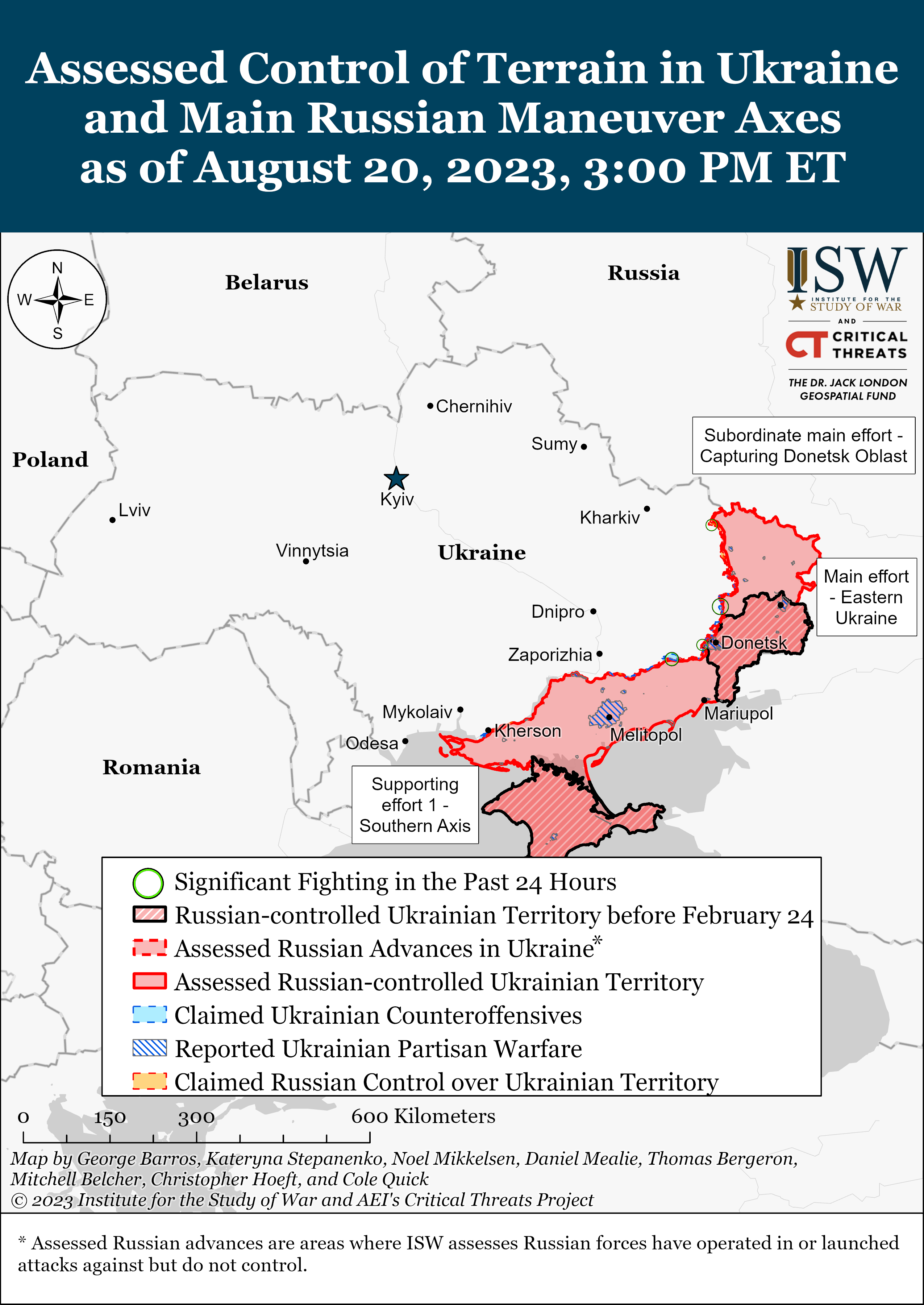
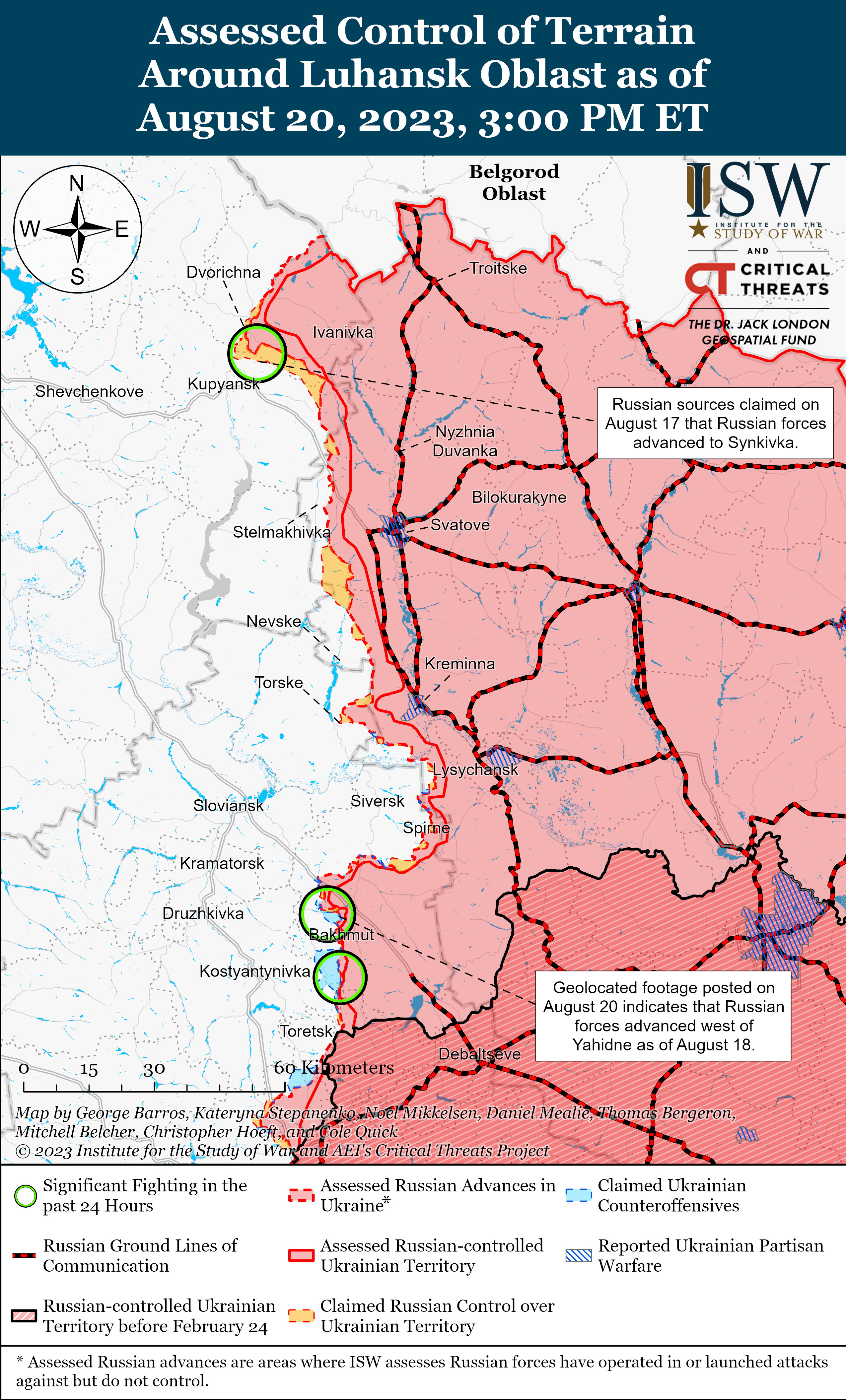

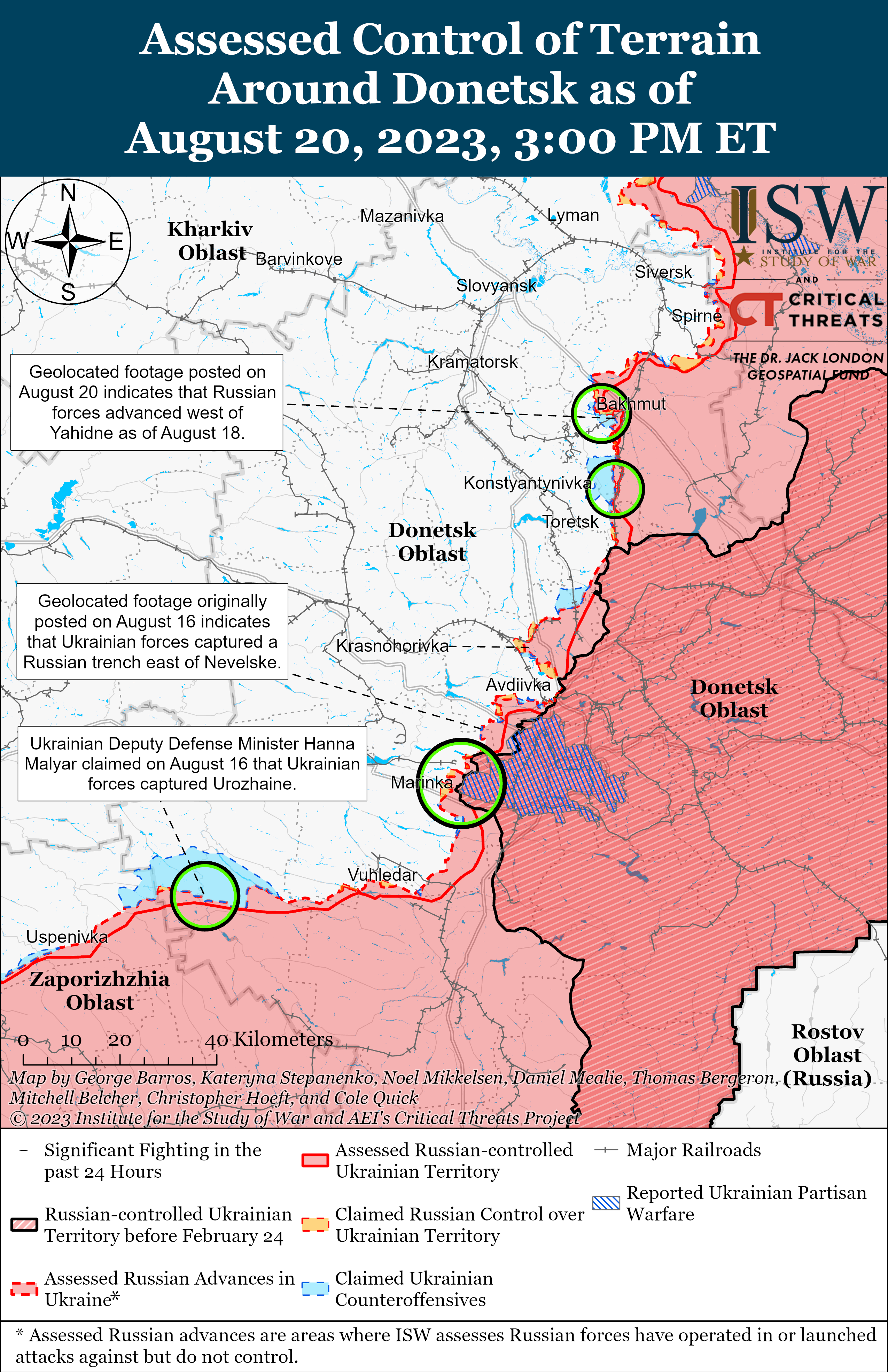
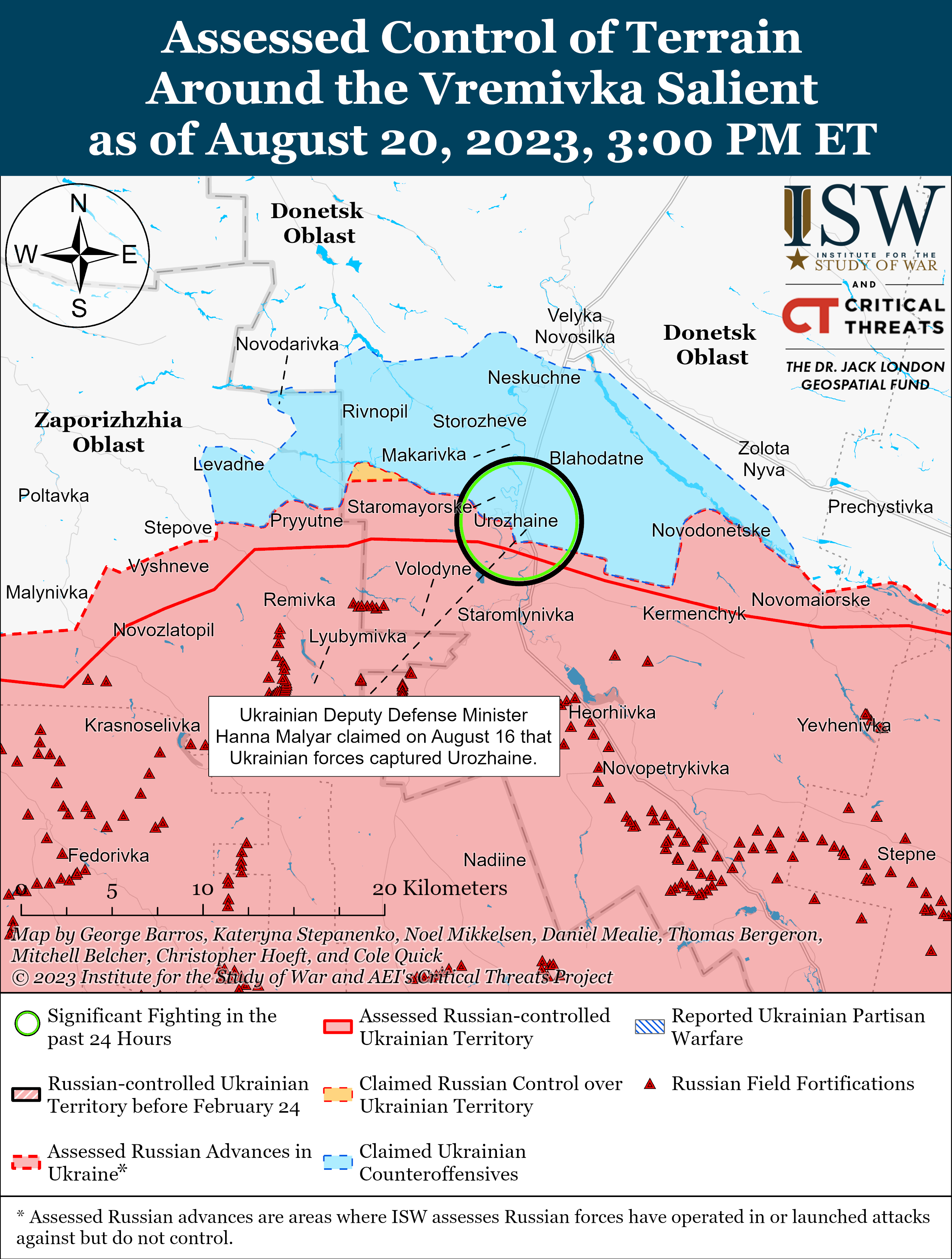
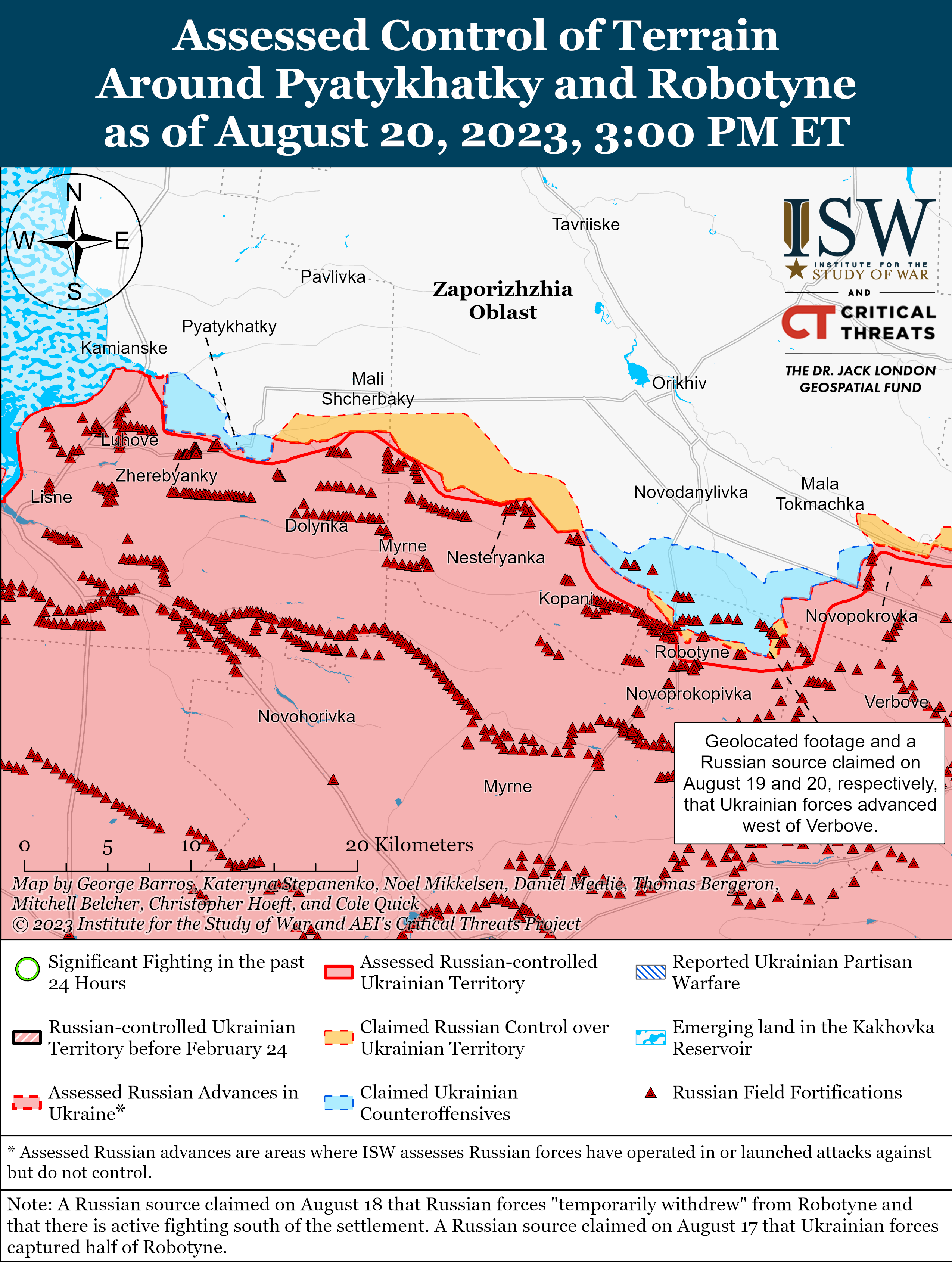
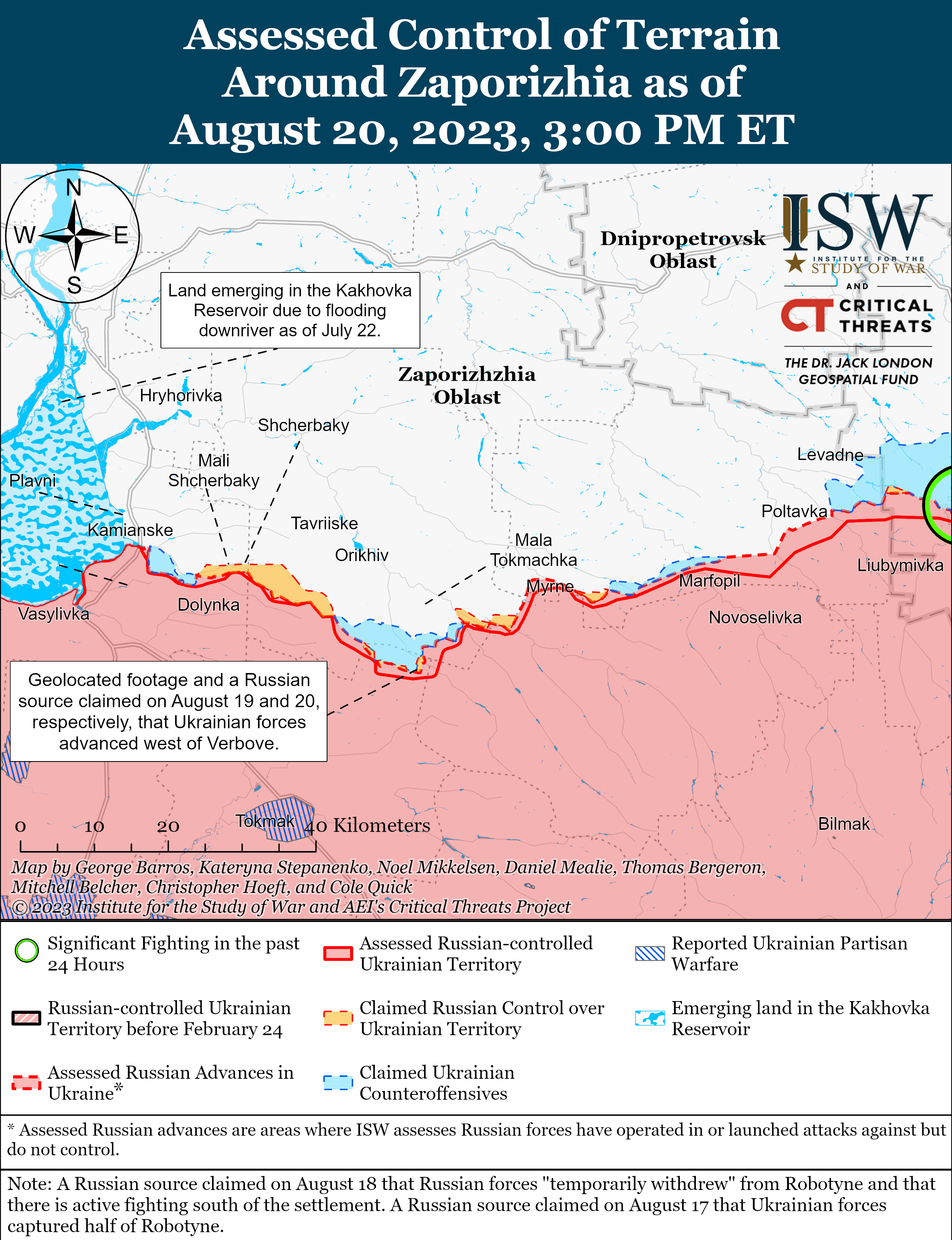
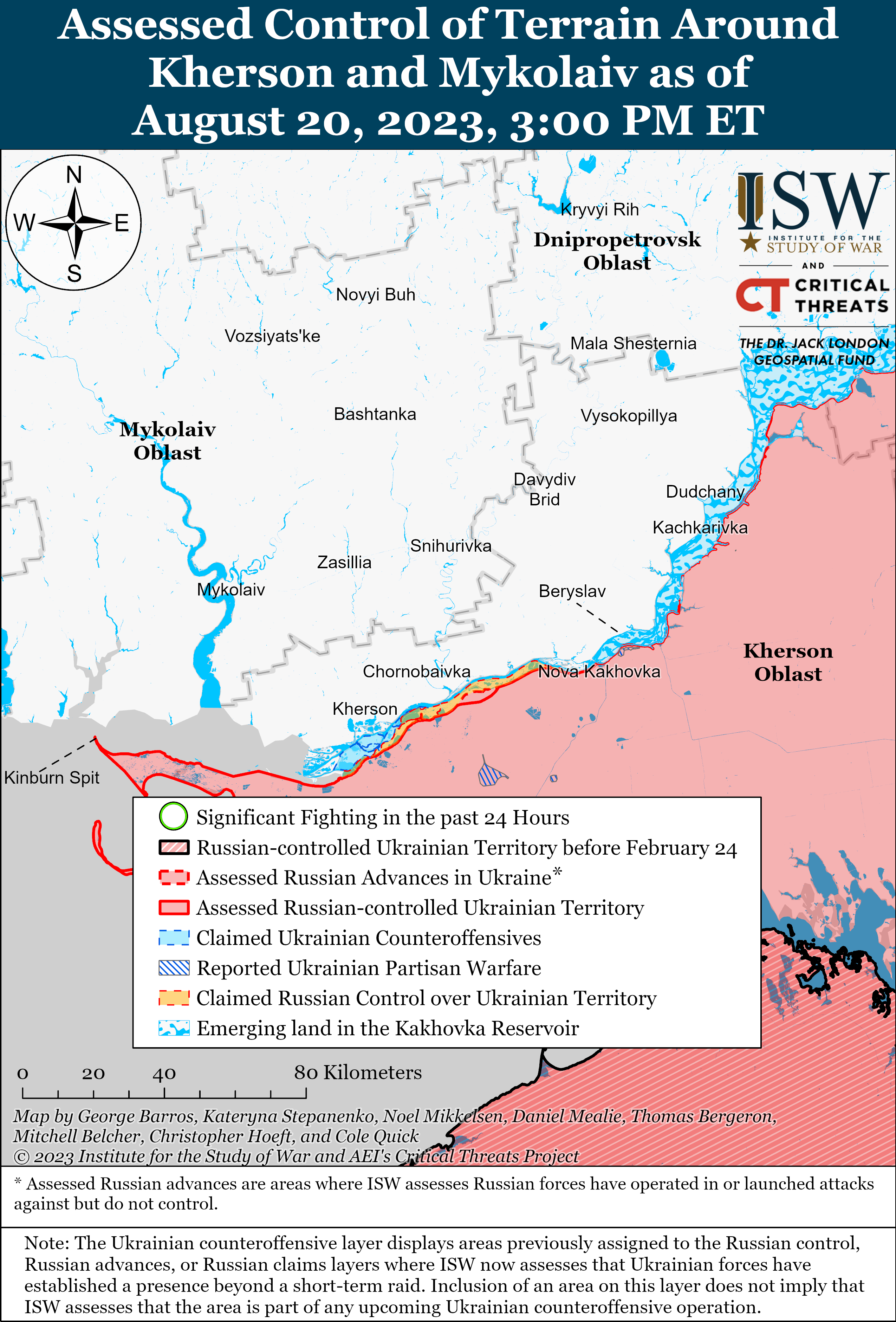
No comments:
Post a Comment